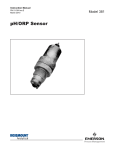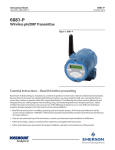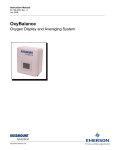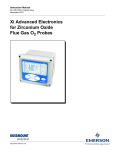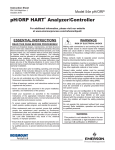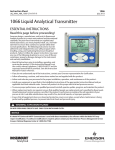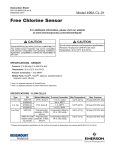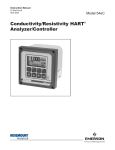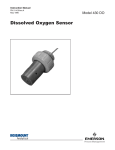Download Emerson Process Management - Emerson Electric Co. Oven 1056 User's Manual
Transcript
Instruction Sheet PN 51A-1056/RevB November 2010 Model 1056 Dual-Input Intelligent Analyzer For additional information, please refer to Instruction Manual 51-1056, rev H or visit www.emersonprocess.com/raihome/liquid ESSENTIAL INSTRUCTIONS READ THIS PAGE BEFORE PROCEEDING! Your instrument purchase from Rosemount Analytical, Inc. is one of the finest available for your particular application. These instruments have been designed, and tested to meet many national and international standards. Experience indicates that its performance is directly related to the quality of the installation and knowledge of the user in operating and maintaining the instrument. To ensure their continued operation to the design specifications, personnel should read this manual thoroughly before proceeding with installation, commissioning, operation, and maintenance of this instrument. If this equipment is used in a manner not specified by the manufacturer, the protection provided by it against hazards may be impaired. • Failure to follow the proper instructions may cause any one of the following situations to occur: Loss of life; personal injury; property damage; damage to this instrument; and warranty invalidation. • Use only factory documented components for repair. Tampering or unauthorized substitution of parts and procedures can affect the performance and cause unsafe operation of your process. • All equipment doors must be closed and protective covers must be in place unless qualified personnel are performing maintenance. • If this equipment is used in a manner not specified by the manufacturer, the protection provided by it against hazards may be impaired. WARNING RISK OF ELECTRICAL SHOCK Equipment protected throughout by double insulation. • Installation and servicing of this product may expose personel to dangerous voltages. • Main power wired to separate power source must be disconnected before servicing. • Do not operate or energize instrument with case open! • Ensure that you have received the correct model and options from your purchase order. Verify that this manual covers your model and options. If not, call 1-800-854-8257 or 949-757-8500 to request correct manual. • Signal wiring connected in this box must be rated at least 240 V. • For clarification of instructions, contact your Rosemount representative. • Unused cable conduit entries must be securely sealed by non-flammable closures to provide enclosure integrity in compliance with personal safety and environmental protection requirements. Unused conduit openings must be sealed with NEMA 4X or IP65 conduit plugs to maintain the ingress protection rating (NEMA 4X). • Follow all warnings, cautions, and instructions marked on and supplied with the product. • Use only qualified personnel to install, operate, update, program and maintain the product. • Educate your personnel in the proper installation, operation, and maintenance of the product. • Install equipment as specified in the Installation section of this manual. Follow appropriate local and national codes. Only connect the product to electrical and pressure sources specified in this manual. • Non-metallic cable strain reliefs do not provide grounding between conduit connections! Use grounding type bushings and jumper wires. • Electrical installation must be in accordance with the National Electrical Code (ANSI/NFPA-70) and/or any other applicable national or local codes. • Operate only with front panel fastened and in place. • Safety and performance require that this instrument be connected and properly grounded through a three-wire power source. • Proper use and configuration is the responsibility of the user. Provide a switch or breaker to disconnect the analyzer from the main power supply. Install the switch or breaker near the analyzer and label it as the disconnecting device for the analyzer. QUICK START GUIDE Model 1056 Dual Input Analyzer 1. Refer to mechanical installation instructions. 2. Wire sensor(s) to the signal boards. See wiring instructions. Refer to the sensor instruction sheet for additional details. Make current output, alarm relay and power connections. 3. Once connections are secured and verified, apply power to the analyzer. WARNING RISK OF ELECTRICAL SHOCK Electrical installation must be in accordance with the National Electrical Code (ANSI/NFPA-70) and/or any other applicable national or local codes. 4. When the analyzer is powered up for the first time, Quick Start screens appear. Quick Start operating tips are as follows: a. A backlit field shows the position of the cursor. b. To move the cursor left or right, use the keys to the left or right of the ENTER key. To scroll up or down or to increase or decrease the value of a digit use the keys above and below the ENTER key . Use the left or right keys to move the decimal point. c. Press ENTER to store a setting. Press EXIT to leave without storing changes. Pressing EXIT during Quick Start returns the display to the initial start-up screen (select language). 5. Complete the steps as shown in the Quick Start Guide flow diagram, Fig. A on the following page. 6. After the last step, the main display appears. The outputs are assigned to default values. 7. To change output, and temperature-related settings, go to the main menu and choose Program. Follow the prompts. For a general guide to the Program menu, see the Quick Reference Guide, Fig.B. 8. To return the analyzer to the default settings, choose Reset Analyzer under the Program menu. CAUTION This product generates, uses, and can radiate radio frequency energy and thus can cause radio communication interference. Improper installation, or operation, may increase such interference. As temporarily permitted by regulation, this unit has not been tested for compliance within the limits of Class A computing devices, pursuant to Subpart J of Part 15, of FCC Rules, which are designed to provide reasonable protection against such interference. Operation of this equipment in a residential area may cause interference, in which case the user at his own expense, will be required to take whatever measures may be required to correct the interference. CAUTION This product is not intended for use in the light industrial, residential or commercial environments per the instrument’s certification to EN61000-6-2. Figure A. QUICK START GUIDE QUICK START GUIDE Figure B. MODEL 1056 MENU TREE QUICK REFERENCE GUIDE SPECIFICATIONS - General Enclosure: Polycarbonate. NEMA 4X/CSA 4 (IP65). Dimensions: Overall 155 x 155 x 131mm (6.10 x 6.10 x 5.15 in.). Cutout: 1/2 DIN 139mm x 139mm (5.45 x 5.45 in.) Conduit Openings: Accepts 1/2” or PG13.5 conduit fittings Display: Monochromatic graphic liquid crystal display. 128 x 96 pixel display resolution. Backlit. Active display area: 58 x 78mm (2.3 x 3.0 in.). Ambient Temperature and Humidity: 0 to 55°C (32 to 131°F). Turbidity only: 0 to 50°C (32 to 122°F), RH 5 to 95% (non-condensing) Storage Temperature Effect: -20 to 60ºC (-4 to 140°F) Hazardous Location Approvals Class I, Division 2, Groups A, B, C, & D Class Il, Division 2, Groups E, F, & G Class Ill T4A Tamb= 50° C Evaluated to the ANSI/UL Standards. The ‘C’ and ‘US’ indicators adjacent to the CSA Mark signify that the product has been evaluated to the applicable CSA and ANSI/UL Standards, for use in Canada and the U.S. respectively Options for CSA: -01, 02, 03, 20, 21, 22, 24, 25, 26, 27, 30, 31, 32, 34, 35, 36, 37, 38, AN, and HT. Note: Turbidity configurations (Models 1056-02-27-38AN/-HT, 1056-03-27-38-AN/-HT, 1056-02-27-37-AN/ -HT and 1056-03-27-37-AN/-HT) are CSA approved Class I Div. 2 for hazardous area installation. Class I, Division 2, Groups A, B, C, & D Class Il & lll, Division 2, Groups E, F, & G T4A Tamb= 50° C Enclosure Type 4X Options for FM: -01, 02, 03, 20, 21, 22, 24, 25, 26, 27, 30, 31, 32, 34, 35, 36, 37, 38, AN, and HT. Note: Turbidity configurations (Models 1056-02-27-38AN/-HT, 1056-03-27-38-AN/-HT, 1056-02-27-37-AN/HT and 1056-03-27-37-AN/-HT) are FM approved Class I Div. 2 for hazardous area installation. Ordinary Locations- The following ordering options are approved by UL: -01, 02, 03, 20, 21, 22, 23, 24, 25, 26, 27, 30, 31, 32, 33, 34, 35, 36, 37, 38, AN, DP, and HT. Note: -UL order code must be specified for UL approval. Model 1056 UL configurations are assembled per UL requirements and are marked UL on the unit. POLLUTION DEGREE 2: Normally only non-conductive pollution occurs. Occasionally, however, a temporary conductivity caused by condensation must be expected. Power: Code -01: 115 VAC ±15% 60 Hz ±6%, 10W; 230 VAC ±15% 50 Hz ±6%, 10 W. Code -02: 20 to 30 VDC. 15 W. Code -03: 84 to 265 VAC, 47 to 63.0 Hz. 15 W. Note: Code -02 and -03 power supplies include four programmable relays Equipment protected by double insulation RFI/EMI: EN-61326 LVD: EN-61010-1 Alarms relays*: Four alarm relays for process measurement(s) or temperature. Any relay can be configured as a fault alarm instead of a process alarm. Each relay can be configured independently and each can be programmed with interval timer settings. Relays: Form C, SPDT, epoxy sealed Maximum Relay Current Resistive 28 VDC 115 VAC 230 VAC 5.0 A 5.0 A 5.0 A Inductive load: 1/8 HP motor (max.), 40 VAC Maximum screw torque for power lead connector and relay terminal blocks is 0.6 N.m CAUTION RISK OF ELECTRICAL SHOCK *Relays only available with -02 power supply (20 - 30 VDC) or -03 switching power supply (84 - 265 VAC) WARNING WARNING Exposure to some chemicals may degrade the sealing properties used in the following devices: Zettler Relays (K1-K4) PN AZ8-1CH-12DSEA Inputs: One or two isolated sensor inputs Outputs: Two 4-20 mA or 0-20 mA isolated current outputs. Fully scalable. Max Load: 550 Ohm. Output 1 has superimposed HART signal (configurations 1056-0X-2X-3X-HT only) Current Output Accuracy: ±0.05 mA @ 25 ºC Terminal Connections Rating: Power connector (3-leads): 18-12 AWG wire size. Signal board terminal blocks: 26-16 AWG wire size. Current output connectors (2-leads): 24-16 AWG wire size. Alarm relay terminal blocks: 18-16 AWG wire size (-02 24 VDC power supply and -03 84-265VAC power supply) Weight/Shipping Weight: (rounded up to nearest lb or nearest 0.5 kg): 3 lbs/4 lbs (1.5 kg/2.0 kg) Altitude: for use up to 2000 meter (6562 ft.) 5 MODEL 1056 INSTALLATION INSTALLATION UNPACKING AND INSPECTION Inspect the shipping container. If it is damaged, contact the shipper immediately for instructions. Save the box. If there is no apparent damage, unpack the container. Be sure all items shown on the packing list are present. If items are missing, notify Rosemount Analytical immediately. INSTALLATION General Information 1. Although the analyzer is suitable for outdoor use, do not install it in direct sunlight or in areas of extreme temperatures. 2. Install the analyzer in an area where vibration and electromagnetic and radio frequency interference are minimized or absent. 3. Keep the analyzer and sensor wiring at least one foot from high voltage conductors. Be sure there is easy access to the analyzer. 4. The analyzer is suitable for panel, pipe, or surface mounting. Refer to the table below. Type of Mounting Figure Panel 2-1 Wall and Pipe 2-2 WARNING RISK OF ELECTRICAL SHOCK Electrical installation must be in accordance with the National Electrical Code (ANSI/NFPA-70) and/or any other applicable national or local codes. 6 FIGURE 2-1 PANEL MOUNTING DIMENSIONS MILLIMETER INCH 17.13 1.1 126.4 5.0 101.6 4.00 154.9 6.1 154.9 6.1 Front View Side View ( 126.4 5.0 ) 76.2 3.0 41.4 1.6 Bottom View 152.73 6.0 The front panel is hinged at the bottom. The panel swings down for easy access to the wiring locations. Panel mounting seal integrity (4/4X) for outdoor applications is the responsibility of the end user. 7 FIGURE 2-2 PIPE AND WALL MOUNTING DIMENSIONS (Mounting bracket PN:23820-00) MILLIMETER INCH 154.9 6.1 Wall / Surface Mount 232 9.1 102 4.0 33.5 1.3 130 5.1 187 7.4 154.9 6.1 165 6.5 Side View Front View Pipe Mount 232 9.1 Bottom View 33.5 1.3 130 5.1 80.01 3.2 165 6.5 45.21 1.8 108.9 4.3 Side View 71.37 2.8 The front panel is hinged at the bottom. The panel swings down for easy access to the wiring locations. 8 MODEL 1056 WIRING WIRING GENERAL The Model 1056 is easy to wire. It includes removable connectors and slide-out signal input boards. The front panel is hinged at the bottom. The panel swings down for easy access to the wiring locations. Removable connectors and signal input boards Model 1056 uses removable signal input boards and communication boards for ease of wiring and installation. Each of the signal input boards can be partially or completely removed from the enclosure for wiring. The Model 1056 has three slots for placement of up to two signal input boards and one communication board. Slot 1-Left Profibus board Slot 2 – Center Input Board 1 Slot 3 – Right Input Board 2 Signal Input boards Slots 2 and 3 are for signal input measurement boards. Wire the sensor leads to the measurement board following the lead locations marked on the board. After wiring the sensor leads to the signal board, carefully slide the wired board fully into the enclosure slot and take up the excess sensor cable through the cable gland. Tighten the cable gland nut to secure the cable and ensure a sealed enclosure. Digital Communication boards A Profibus DP communication board is available as an ordering option for Model 1056 digital communication. Profibus DP is an open communications protocol which operates over a dedicated digital line to the host. HART digital communications are also available as an ordering option. HART circuitry is embedded in the main PCBA; there is no separate slide-in communications board. HART supports Bell 202 digital communications over an analog 4-20mA current output. Alarm relays Four alarm relays are supplied with the switching power supply (84 to 265VAC, -03 order code) and the 24VDC power supply (20-30VDC, -02 order code). All relays can be used for process measurement(s) or temperature. Any relay can be configured as a fault alarm instead of a process alarm. Each relay can be configured independently and each can be programmed as an interval timer, typically used to activate pumps or control valves. As process alarms, alarm logic (high or low activation or USP*) and deadband are user-programmable. Customer-defined failsafe operation is supported as a programmable menu function to allow all relays to be energized or not-energized as a default condition upon powering the analyzer. The USP* alarm can be programmed to activate when the conductivity is within a user-selectable percentage of the limit. USP alarming is available only when a contacting conductivity measurement board is installed. PREPARING CONDUIT OPENINGS There are six conduit openings in all configurations of Model 1056. (Note that four of the openings will be fitted with plugs upon shipment.) Conduit openings accept 1/2-inch conduit fittings or PG13.5 cable glands. To keep the case watertight, block unused openings with NEMA 4X or IP65 conduit plugs. NOTE: Use watertight fittings and hubs that comply with your requirements. Connect the conduit hub to the conduit before attaching the fitting to the analyzer. 9 MODEL 1056 WIRING POWER, OUTPUT, AND SENSOR CONNECTIONS Power wiring The following power wiring instructions apply to all configurations for Model 1056. The power terminal can be wired with 18 - 12 AWG wire sizes. Wiring must be rated for 75°C or higher. Ensure that power has been turned off to the power leads during this installation. Three Power Supplies are offered for Model 1056: a. 115/230VAC Power Supply (-01 ordering code) b. 24VDC (20 – 30V) Power Supply (-02 ordering code) c. 84 – 265 VAC Switching Power Supply (-03 ordering code) AC mains (115 or 230V) leads and 24VDC leads are wired to the Power Supply board which is mounted vertically on the left side of the main enclosure cavity. Each lead location is clearly marked on the Power Supply board. Wire the power leads to the Power Supply board using the lead markings on the board. The grounding plate is connected to the earth terminal of power supply input connector TB1 on the -01 (115/230VAC) and -03 (84-265VAC) power supplies. The green colored screws on the grounding plate are intended for connection to some sensors to minimize radio frequency interference. The green screws are not intended to be used for safety purposes. For UL-approved configurations of Model 1056 (1056-XX-XX-XX-XX-UL) a clear plastic protective shield is installed that surrounds the power supply connections. To wire power leads to the power supply: a. Route the power cable or individual power leads through an appropriate cable gland fittings or conduit and through the left front instrument enclosure opening for the -01 supply. The -02 and -03 power supplies may be wired through either the front left or rear left conduit entry holes. b. Route the leads up through the bottom of the plastic shield surrounding the power supply board. c. Open the door of the plastic shield to gain access to the wiring connections. The door is locked to the protective shield with plastic tabs. d. Remove the mating connector (location TB1 on the PCB) for the power connections. e. Wire the individual leads to the modular mating connector for power connections. f. Insert the wired modular connector into the board-mounted mating connector (TB1) on the power supply board. The connector is keyed. g. Close the door of the plastic shield and secure it using the plastic locking tabs. h. Make sure to properly seal the power wires that exit the enclosure with the appropriate cable glands or pipe fittings to ensure a NEMA-compliant enclosure. 115/230VAC Power Supply (-01 ordering code) is shown below: CAUTION AC Power switch shipped in the 230VAC position. Adjust switch upwards to 115VAC position for 110VAC – 120VAC operation. 10 MODEL 1056 WIRING 24VDC Power Supply (-02 ordering code) is shown below: This power supply automatically detects DC power and accepts 20VDC to 30VDC inputs. Four programmable alarm relays are included. Switching AC Power Supply (-03 ordering code) is shown below: This power supply automatically detects AC line conditions and switches to the proper line voltage and line frequency. Four programmable alarm relays are included. Current Output wiring All instruments are shipped with two 4-20mA current outputs. Wiring locations for the outputs are on the Main board which is mounted on the hinged door of the instrument. Wire the out put leads to the correct position on the Main board using the lead markings (+/positive, -/negative) on the board. Male mating connectors are provided with each unit. Sensor wiring to signal boards Wire the correct sensor leads to the measurement board using the lead locations marked directly on the b o a r d . After wiring the sensor leads to the signal board, carefully slide the wired board fully into the enclosure slot and take up the excess sensor cable through the cable gland. For best EMI/RFI protection use shielded output signal cable enclosed in an earth-grounded metal conduit. Connect the shield to earth ground. AC wiring should be 14 gauge or greater. Provide a switch or breaker to disconnect the analyzer from the main power supply. Install the switch or breaker near the analyzer and label it as the disconnecting device for the analyzer. Keep sensor and output signal wiring separate from power wiring. Do not run sensor and power wiring in the same conduit or close together in a cable tray. WARNING RISK OF ELECTRICAL SHOCK Electrical installation must be in accordance with the National Electrical Code (ANSI/NFPA-70) and/or any other applicable national or local codes. 11 MODEL 1056 RETURN OF MATERIAL RETURN OF MATERIAL GENERAL To expedite the repair and return of instruments, proper communication between the customer and the factory is important. Before returning a product for repair, call 1-949-757-8500 for a Return Materials Authorization (RMA) number. WARRANTY REPAIR The following is the procedure for returning instruments still under warranty: 1. Call Rosemount Analytical for authorization. 2. To verify warranty, supply the factory sales order number or the original purchase order number. In the case of individual parts or sub-assemblies, the serial number on the unit must be supplied. 3. Carefully package the materials and enclose your “Letter of Transmittal” (see Warranty). If possible, pack the materials in the same manner as they were received. 4. Send the package prepaid to: IMPORTANT Rosemount Analytical Liquid Division 2400 Barranca Parkway Irvine, CA 92606 Please see second section of “Return of Materials Request” form. Compliance with the OSHA requirements is mandatory for the safety of all personnel. MSDS forms and a certification that the instruments have been disinfected or detoxified are required. Attn: Factory Repair RMA No. ____________ Mark the package: Returned for Repair Model No. ____ NON-WARRANTY REPAIR The following is the procedure for returning for repair instruments that are no longer under warranty: 1. Call Rosemount Analytical for authorization. 2. Supply the purchase order number, and make sure to provide the name and telephone number of the individual to be contacted should additional information be needed. 3. Do Steps 3 and 4 from warranty repair section. NOTE Consult the factory for additional information regarding service or repair. The right people, the right answers, right now. ON-LINE ORDERING NOW AVAILABLE ON OUR WEB SITE http://www.raihome.com 8 Credit Cards for U.S. Purchases Only. Emerson Process Management 2400 Barranca Parkway Irvine, CA 92606 USA Tel: (949) 757-8500 Fax: (949) 474-7250 http://www.raihome.com © Rosemount Analytical Inc. 2010












